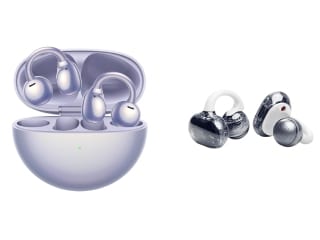- Home
- Wearables
- Wearables Reviews
- Samsung Galaxy Watch Review
Samsung Galaxy Watch Review

Smartwatches have been around for a long time now. Very few have managed to make as much of an impact as the Apple Watch, but that hasn't stopped manufacturers from trying, has it? We have seen multiple smartphone manufacturers trying their hands at making the perfect smartwatch. Most of them have opted for Google's Wear OS platform which is based on Android. On the other hand, Samsung originally started off with Android Wear but has now switched to its own Tizen-based OS. One of the latest additions to Samsung's list is the recently launched Galaxy Watch.
The new watch sticks to the popular circular design and packs in multiple sensors that can help you track your fitness goals. With so many smartwatches already in the market, should you put your money on the Galaxy Watch? We put it to the test for the answer.
Samsung Galaxy Watch design
The Galaxy Watch is definitely well designed, and Samsung has paid good attention to detail. It is available in two different sizes — 42mm and 46mm. If you are looking at the 42mm model, you get to choose between two colours, Midnight Black and Rose Gold. The bigger 46mm variant is only available in Silver. If you like big chunky dials, you'll have to settle for the latter.
All models also have a rotating bezel to aid UI navigation. Compared to using the touchscreen all the time, it is far easier and more convenient to use the rotating bezel. It offers good clicky feedback which always lets you know how much input you have dialed in. This means you don't necessarily have to look down at the watch to navigate through its options.
We had the 46mm variant of the Galaxy Watch for review. The bezel is finished in black and it complements the silver case very well. Samsung has applied the same treatment to the two buttons on the right as well. The upper one is the back button, while the other is the home button. You'll also see a microphone just below these buttons on the right. The left side of the watch only houses a speaker.
Turn the watch around and you will see the heart rate sensor in the centre. There's also hardware for wireless charging here. You get a wireless charger in the box, which reminded us of the charger bundled with the Moto 360 Gen 2. The charging cradle has a Micro-USB port and the supplied charger is rated at 3.5W.
At the heart of the case is a 1.3-inch AMOLED display with a layer of Corning Gorilla Glass DX+ for protection. The 42mm variant of the Galaxy Watch features a smaller 1.2-inch screen instead. Since the display is AMOLED you get an always-on display mode. When enabled, the display does not turn black and white. you still get full colour on the watch faces, which is very good. The Galaxy Watch has an IP68 rating, and Samsung claims it is water resistant upto 5ATM. It is also shockproof and has a MIL-STD-810G rating.
![]() The Galaxy Watch has a heart rate sensor at the back
The Galaxy Watch has a heart rate sensor at the back
The black 22mm watch bands we received with our 46mm review unit are made out of silicone. The 42mm Galaxy Watch uses a 20mm strap. Samsung's default strap has quick-release pins that make it easy to swap it out without needing any special tools. While we found the band to be comfortable and sweat resistant, you can use any other standard watch band to match your outfit.
Samsung Galaxy Watch specifications, software, and features
Just like most other Samsung devices, the Galaxy Watch sports an Exynos processor. In this case, it is an Exynos 9110 SoC, which is a dual-core processor clocked at 1.15GHz. The Galaxy Watch comes in Bluetooth and LTE variants internationally, but Samsung has only launched Bluetooth versions of each in India. The Bluetooth version gets 768MB of RAM while the LTE variant has 1.5GB of RAM. We had the Bluetooth version for this review. Both variants have 4GB of internal storage, and we saw that there was only 1.5GB available for us to use.
The storage space can be used to store music and photos, and install apps on the watch. Transferring songs and photos to the watch is easy, and the companion app does a good job. We could pair Bluetooth headphones with the watch and listen to music off it, or we could also use the loudspeaker. This makes the Galaxy Watch pretty handy for people who don't want to carry an extra device to the gym, or for that quick jog in the morning.
The Galaxy Watch runs Samsung's Tizen-based Wearable OS 4.0, and is compatible with Android smartphones (version 5.0 and above) and iPhones (iPhone 5 and later running at least iOS 9). Android phones need to have more than 1.5GB of RAM. Connectivity options on the watch include Bluetooth 4.2, WiFi 802.11 b/g/n, NFC, A-GPS, and Glonass. NFC is mainly for Samsung Pay, but that functionality hasn't been enabled in India yet. You also get an accelerometer, gyroscope, barometer, heart rate sensor, and ambient light sensor on the watch.
![]()
The 46mm Galaxy Watch has a 472mAh battery and weighs 81.5g (63g without the strap) while the 42mm watch sports a 270mAh battery and weighs 49g for the body only. We were using the Galaxy Watch primarily with a Google Pixel 3 (Review), and it only needed the Galaxy Wearable app and the Galaxy Watch Plugin to work.
We found the app to be feature-rich. You can customise the appearance of the watch face and download more faces if you want. You have control over notifications and canselect the apps that notify you on the smartwatch. Widgets are a core part of the Galaxy Watch and there are multiple ones for most apps. You can set a widget to keep track of your water or caffeine intake throughout the day, for example. There are also some that help you track your stress level when you want, or suggest breathing exercises if it is too high. These can be customised on the watch itself or via the smartphone app.
The Galaxy Wearable app lets you choose an app to launch quickly by double-pressing the home button on the watch. Triple-pressing the home button sends out an SOS request. The app allows you to select up to four contacts who will receive an SMS and one that will be called when you triple-press the home button in an emergency. Since the watch has a speaker and a microphone, you can make and receive calls using it as long as your phone is connected via Bluetooth.
Samsung's Bixby makes its wearable debut on this watch. You can wake it by saying “Hi Bixby” when the display is on, and follow that with a voice command. It is capable of doing basic tasks such as setting an alarm or calling a contact. The voice recognition isn't great and we had to repeat some commands multiple times for it to get them right. Asking questions, like “What is the capital on India?” resulted in the watch displaying “Please check it on device”, but our connected Pixel 3 did not display anything. We also found Bixby to be slower than the Google Assistant functionality that we used on the Misfit Vapor.
The Galaxy Watch has multiple fitness features that you can take advantage of using the Samsung Health app. This is also the main app that does all the fitness tracking for the Galaxy Watch. You can track the number of steps you take, your heart rate and stress levels, and also your calorie, water, and caffeine intake. There are three heart rate tracking options as well. You can set it to Always to keep the heart rate sensor on at all times; Frequent, which takes a reading every 10 minutes when you are still; and Never, which only lets you take readings manually by tapping ‘Measure'.
![]() The bigger, 46mm Galaxy Watch is only available in Silver
The bigger, 46mm Galaxy Watch is only available in Silver
There is also an option to compare your step count with friends who are using the Samsung Health app. You can record different workout types such as walking, running, swimming, and a lot more. We checked that there were 43 workouts listed in the app, including specific exercises such as crunches, lunges, jumping jacks, and push-ups.
One issue with the Tizen-based OS is that app support is limited. While you will be able to find multiple watch faces for the device, we found that we couldn't find popular apps like Navigation, Uber, and Telegram in Samsung's app store. Some of the apps available needed a companion app on the phone to function.
Samsung Galaxy Watch performance and battery life
The AMOLED display on the Galaxy Watch has good viewing angles and the ambient light sensor adjusts brightness automatically. We found the brightness to be adequate when outdoors, making the watch easy to use. The screen is quite responsive but we found ourselves using the rotating bezel a lot more. We loved the clicky feedback of the bezel which let us dial in the specific amount of input required.
Even with biking gloves on, the bezel was easy to operate. Samsung has also added other functionality to this bezel which is interesting. For example, for an incoming call you can turn the bezel clockwise to answer the call on the watch or counterclockwise to disconnect it. We did take quite a few calls on the Galaxy Watch butwe had to raise it to our ear to hear the caller clearly. However, the callers did not complain about our voice quality while talking using the watch.
We did not encounter any lag or stuttering in the UI, and the overall usage experience was quite good. The watch vibrates for incoming notifications and you do have the option to reply to them. You can type using an onscreen keyboard, reply using speech-to-text, or select from message templates. If you wish, you can also add up to 30 custom quick-reply messages. We also noticed that the watch would vibrate to notify us when our paired phone's battery was running low.
![]() The Galaxy Watch reminds you to move if you have been inactive for a long time
The Galaxy Watch reminds you to move if you have been inactive for a long time
To check how accurate fitness tracking is on the Galaxy Watch we used while trying out different workouts over the course of two weeks. The Galaxy Watch is capable of helping you track your steps and lets you set a daily step goal. When we could not meet the average step goal for the week, the watch suggested that we lower it to a more manageable number. While this feature is nice we found the step tracking was slightly off. We counted 1000 steps manually, but the Watch measured only 981 steps.
We tracked a small walk along a path which we know is 1km long, and at the end, the Galaxy Watch displayed 1.10kms. Our test path has a few covered patches which are known to throw GPS trackers off. We did a second test in an open area with the Pixel 3 in airplane mode to force the watch to rely on its internal GPS capabilities. At the end of a 2km walk, the watch reported 2.01kms which is impressive. So if you want to track your runs, the Galaxy Watch is capable of doing it very well in open areas.
The Galaxy Watch also has automatic workout detection. While playing squash, the watch automatically started tracking it and listed it as a Dynamic Workout. It also began to log our heart rate continuously, overriding the Frequent setting that we had chosen. We played three matches, and the watch was able to log them fairly well.
The heart rate sensor is also quick to measure changes in heart rate. While most WearOS devices do not support sleep tracking right out of the box, Samsung has built this function into the Galaxy Watch. Since the watch isn't heavy you can wear it while sleeping. How the watch tracks sleep depends on which heart rate monitoring option you select. If you have set it to Always, it will give you a detailed analysis of your sleep. This includes waking, REM sleep, light sleep, and deep sleep times. If you have set heart rate tracking to Frequent, sleep is broken down into motionless, light, and restless. We found sleep tracking to be accurate, and the watch could detect times when we woke up in the middle of the night for a snack and went back to sleep. It also displays sleep “efficiency” in the sleep report it generates every morning but does not mention what we can do to improve it.
![]() Automatic workout tracking feature is available on the Galaxy Watch
Automatic workout tracking feature is available on the Galaxy Watch
Battery life is what makes the Galaxy Watch stand out from its competitors. We took the watch off its charger on a Monday morning, and the battery was at a full 100 percent. We were able to go for three days without the Always-on Display, with heart rate tracking set to Always, and sleep tracking enabled every night. This is impressive, considering that the watch kept buzzing for multiple notifications each day.
We could manage close to four days by switching heart rate tracking to Frequent, even after enabling the always-on display. We did not have the 42mm Galaxy Watch for testing but you can expect lower battery life from it considering its smaller battery capacity. When we finally did manage to run out of juice, it took us 1 hour 25 minutes to charge the watch to 50 percent, and 2 hours 50 minutes to charge it completely. Considering the fitness tracking and smartwatch functionality that the Galaxy Watch packs, this battery life is better than what you'd get from most other smartwatches on the market.
Verdict
With smartwatches powered by Google's Wear OS failing to really explode in popularity, and the Apple Watch being tied down only to iPhones, the Samsung Galaxy Watch might have a market for itself. It manages to do a little bit of everything, and does it all well. Battery life is the strongest weapon in its arsenal, and other smartwatch companies need to work on this to make life better for the consumer.
That said, there are a few things that don't work in favour of the Galaxy Watch. The Tizen Wearable OS that it is running on has limited app support and users will most likely not find the apps they are looking for, compared to a Wear OS device or an Apple Watch.
The second stumbling block is the price. At Rs. 29,990 and Rs. 24,990 for the 46mm and the 42mm Galaxy Watch Bluetooth models respectively in India, they are slightly expensive compared to other options in the market. The Apple Watch Series 3 is currently retailing for Rs. 27,900 and Rs. 25,900 online for the 42mm and 38mm models respectively, making them better options for people using an iPhone. For people on Android, the asking price of the Galaxy Watch does feel a bit too high compared to WearOS devices such as the Misfit Vapor, which is retailing for Rs. 14,495.
Samsung did have an offer for Galaxy Note 9 (Review) buyers, letting them buy the 42mm Galaxy Watch for just Rs. 9,999. Similar offers in the future would make buying this wearable a no-brainer. At its retail price, though, we think that potential buyers might think twice.
Pros
- Excellent battery life
- Crisp display
- Built-in sleep tracking
- Useful rotating bezel
Cons
- Weak app ecosystem
- Bixby could be better
Ratings (out of 5)
- Design and comfort: 4.5
- Tracking accuracy: 4
- Software and ecosystem: 3
- Battery life 4.5
- Overall: 4
Catch the latest from the Consumer Electronics Show on Gadgets 360, at our CES 2026 hub.
Related Stories
- Samsung Galaxy Unpacked 2025
- ChatGPT
- Redmi Note 14 Pro+
- iPhone 16
- Apple Vision Pro
- Oneplus 12
- OnePlus Nord CE 3 Lite 5G
- iPhone 13
- Xiaomi 14 Pro
- Oppo Find N3
- Tecno Spark Go (2023)
- Realme V30
- Best Phones Under 25000
- Samsung Galaxy S24 Series
- Cryptocurrency
- iQoo 12
- Samsung Galaxy S24 Ultra
- Giottus
- Samsung Galaxy Z Flip 5
- Apple 'Scary Fast'
- Housefull 5
- GoPro Hero 12 Black Review
- Invincible Season 2
- JioGlass
- HD Ready TV
- Laptop Under 50000
- Smartwatch Under 10000
- Latest Mobile Phones
- Compare Phones
- OPPO A6c
- Samsung Galaxy A07 5G
- Vivo Y500i
- OnePlus Turbo 6V
- OnePlus Turbo 6
- Itel Zeno 20 Max
- OPPO Reno 15 Pro Mini 5G
- Poco M8 Pro 5G
- Lenovo Yoga Slim 7x (2025)
- Lenovo Yoga Slim 7a
- Realme Pad 3
- OPPO Pad Air 5
- Garmin Quatix 8 Pro
- NoiseFit Pro 6R
- Haier H5E Series
- Acerpure Nitro Z Series 100-inch QLED TV
- Asus ROG Ally
- Nintendo Switch Lite
- Haier 1.6 Ton 5 Star Inverter Split AC (HSU19G-MZAID5BN-INV)
- Haier 1.6 Ton 5 Star Inverter Split AC (HSU19G-MZAIM5BN-INV)
















